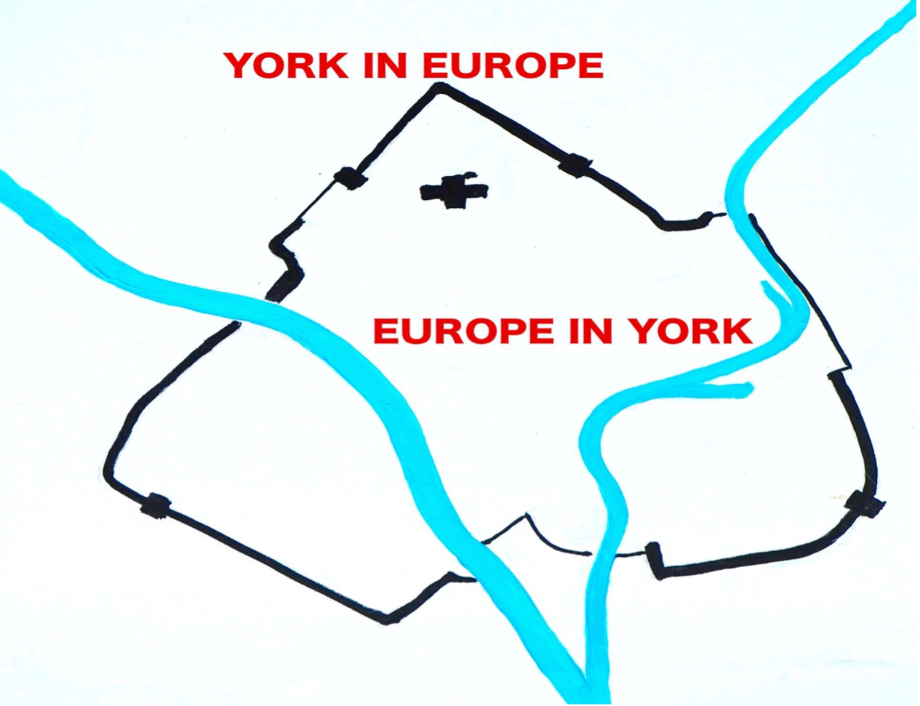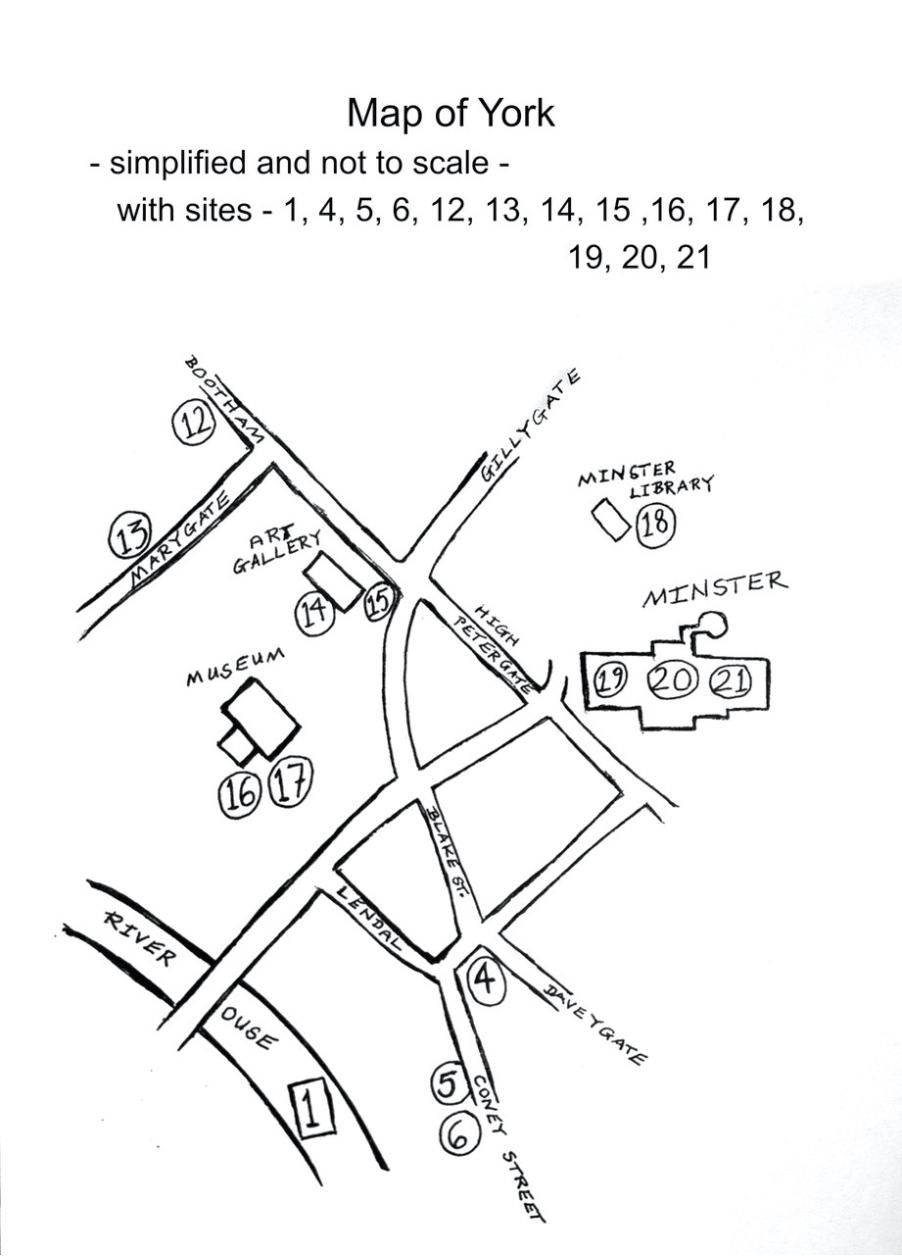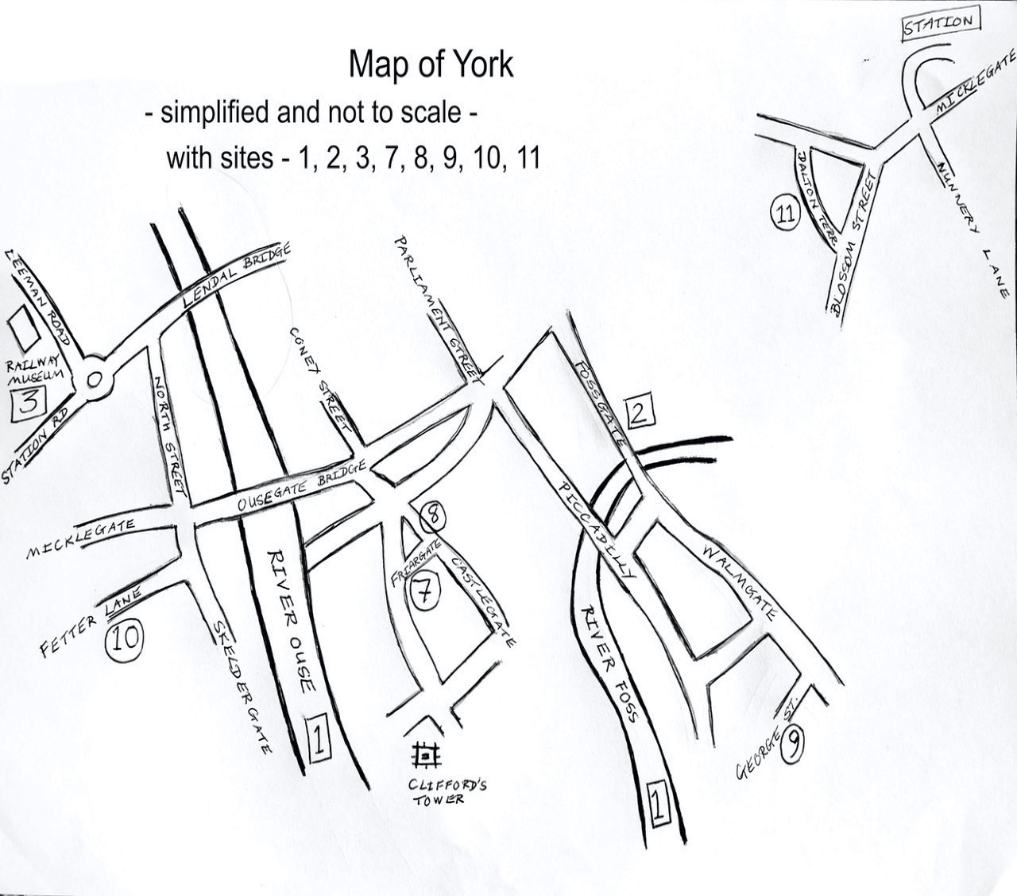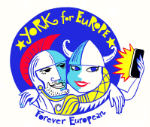
York has always been in the heart of Europe. Whilst Roman Eboracum and Viking Jorvik are all around us, many more countries of Europe have their markers in the city to the present day.
Explore York’s wide European heritage in this trail – through buildings, businesses, communities and individual stories and belongings.
The trail starts with three key points of York’s European connections, which merit a special visit in themselves: the old trading rivers of the Ouse and Foss, the historic Merchant Adventurers’ Hall, and the National Railway Museum which celebrates our modern rail links across the Channel.
The trail moves on to highlight individual European countries alive in York today and it apologises to our Romans and Vikings: since you are already visible everywhere, the trail has side-lined you a little to allow the limelight onto other countries. However, you are still there in some remarkable personal items you left behind for us to find.
Sketch maps of the trail and a list of countries with their
numbered sites are attached at the end.
Follow this link to
go directly.
1. THE RIVERS OUSE & FOSS
(ITALY, GERMANY, IRELAND, SCANDINAVIA, SPAIN & THE WIDER WORLD)
York has had a long history of European and world-wide water-borne trade along its two rivers.
Excavations on the banks of the rivers revealed Roman jetties, wharves and warehouses.
The Vikings, arriving in 866, were world-wide traders from the European continent to China: they imported, for example, amber and furs from SCANDINAVIA, copper alloy pins from IRELAND, pottery from GERMANY – as well as silk from China and the Middle East.
After the Norman conquest in 1066, other imports included olive oil, figs and raisins from SPAIN, whilst York merchants exported wool, grain and cloth to Northern Europe. By 14th century, York with its Merchant Adventurers’ Guild (see below) was England’s wealthiest city after London.
York water-borne trade declined significantly in the late 16th century, as sea-going ships could no longer navigate the rivers due to their size and the silting up of the rivers.
2. MERCHANT ADVENTURERS’ HALL, FOSSGATE ON THE RIVER FOSS (GERMANY, POLAND, PORTUGAL – AND WIDER EUROPE)
In the Middle Ages most cities had several guilds bringing together people with particular trades or crafts. There were more than 50 craft guilds in medieval York. The most important guild was the Company of Merchant Adventurers. Founded in 1356 for charitable and religious purposes, it soon developed its commercial side. Its members mostly exported wool and cloth across Europe, and imported wine and other goods.
The hall is the historical hub of York’s links with mainland Europe over the centuries.
Quick tasters of York’s European trade through GERMANY, PORTUGAL AND POLAND:
In the Governor’s Parlour, the modern stained glass window shows York’s international trade with ships sailing in and out of the city. Indeed, the Company’s valuables were kept safe in a 17th century chest brought from Nuremberg in GERMANY.
Shipping port wines to York from Porto in PORTUGAL: York and
Porto in PORTUGAL have long been linked by marriage. The
House of Croft in Porto, founded in 1678, was one of the earliest
shippers of port. The distinguished merchant family, Thompson of
York, had been trading with PORTUGAL since 1660 and when, in
1681, Thomas Croft married* Frances, daughter of Sir Stephen
Thompson, the two families combined their business interests in the
wine trade.
*They were married at St John’s Church on the junction of Ousegate
and Micklegate. Now redundant, it became an arts centre and most
recently a café-bar.
A truly adventurous tale of a voyage gone wrong is found in the Hall records: in 1468, the Valentyne of Newcastle, a ship filled with goods and crew from York, was sailing to what is now POLAND and anchored offshore in order to pay customs. However, seeing some of the crew disembark, members of the Hanseatic League, an organisation which controlled trade in the area, saw their chance and took over the ship, seized its cargo, and imprisoned the crew for months.
3. THE NATIONAL RAILWAY MUSEUM, LEEMAN ROAD (EUROPE, FRANCE)
Voted European Museum of the Year in 2001.
Here we have how we crossed the Channel to the European mainland by
rail from the early days to the present. On display is a 1936
Wagon-lits Sleeping Car from the former Night Ferry Service from
London to Paris, donated in 1984, and a section of the Channel
Tunnel train which arrived at the museum in 1992.
4. BETTY’S TEAROOMS, ST. HELEN’S SQUARE (BELGIUM, ENGLAND, FINLAND, FRANCE, POLAND, SCOTLAND, SWITZERLAND, ULSTER)
Betty’s was founded by Swiss baker and chocolatier Fritz Bützer just over 100 years ago. He went first to France where he trained in the art of confectionery and later to England, where he changed his name to Frederick Belmont.
Betty’s in World War II: Betty’s had a cocktail bar on the ground floor and another bar in the basement. In the war years, the bar, known as The Dive, was popular with servicemen and women stationed in the airbases around York, from Canada, New Zealand, Australia, as well as UK and other countries in Europe.
600 servicemen and women scratched their names on a mirror downstairs. Today several sections of the mirror, which was damaged during an air raid, hang in the downstairs Oak Room. Here are some of the names from European countries:
Joseph Boucard (sailor) Nantes, France
Tom Cramer, Switzerland
G.C. Daniel, Ghent, Belgium
Margaret Naef, Finland
Brian Leckley, Ulster
N. Puck, P/O Poland
J. Watt, Glasgow, Scotland
Norman Cyril Jackson, Ealing, London, England (Included as part of an international team.)
(Source: Betty’s – Bombercrew.com Forum)
5. CONEY STREET, the turning to Cityscreen (FRANCE)
A blue plaque of York Civic Trust commemorating Yves Mahé, a French airman in World War II, who "helped to save York from Luftwaffe bombers" on 29th April 1942.
In the York Baedeker Raid * over 95 civilians were killed and there was damage to around a third of the homes in the city, the medieval Guildhall, the railway station, a Rowntree chocolate factory near the river, the Bar Convent, and a number of schools including St Peter’s of which Guy Fawkes is an Old Boy.
23-year-old Yves Mahé, who had escaped from occupied France to join the RAF, is credited with almost single-handedly saving York. He was already in the air and saw the city ablaze from a distance. In his Hawker Hurricane, he shot down a Heinkel, then targeted a Junkers JU88 bomber. After 90 minutes, the German planes left.
One of the bombers, a Dornier Do17, later crashed near Castle Howard.
Yves Mahé was given a civic reception at the Mansion House with Free French flags flying over the city. Later General de Gaulle awarded him the Croix de Guerre.
He went on to fly with French Squadrons alongside the Soviet Air Force, was shot down and captured in August 1944 but escaped and returned to France.
He died in 1962 in an accident whilst flying a jet night-fighter with the French Air Force in Belgium. He was 42.
* Baedeker raids were named after the famous German travel guides. Germany launched a series of raids on historic towns in the UK in 1942. According to the Imperial War Museum, it is thought these were reprisals for earlier RAF bombing of Lübeck and other historic German towns.
6. ST MARTIN’S CHURCH, CONEY STREET (opposite Yves Mahé’s blue plaque) (GERMANY)
On 29 April 1942, a bomb struck St Martin’s and almost completely destroyed the medieval building. Only the tower and south aisle survived the blast. It was rebuilt in the 1960s on a smaller scale and dedicated as “A shrine to all who died in the two World Wars, a chapel of peace and reconciliation between nations and men.” The organ at the back of the church was a gift from the German government and Evangelical Church in 1968 and there is a memorial to all the people who died in the 1942 raids, including the German airmen.
7. FRIENDS MEETING HOUSE, FRIARGATE (CZECH REPUBLIC/SLOVAKIA)
The York Liberal Jewish community hold their services at the Friends Meeting House. They prize a Czech Torah scroll which was rescued from the Holocaust in World War II and lent to the York Community by the Memorial Scrolls Trust. The trust looks after nearly 1,600 Czech scrolls rescued from the Holocaust.
How Czech Torah scrolls were saved in World War II
In 1942, members of Prague’s Jewish community devised a way to bring the religious treasures from the deserted communities and destroyed synagogues to the comparative safety of the Prague Jewish Museum. The Nazis were persuaded to accept the plan and more than 100,000 artefacts were rescued. Among them were the Torah scrolls.
After the war, the scrolls were transferred to the ruined synagogue at Michle outside Prague where they remained until they came to London in the 1960s.
The scrolls were repaired and the decision taken to lend them out to Jewish communities around the world, to bring new Jewish life where the Nazis had sought to destroy it.
Further information: memorialscrollstrust.org
York has a tragic place in Jewish history, remembered for the massacre of the Jewish community in 1190. In modern times, there have been two organised Jewish congregations, the York Hebrew Congregation, whose synagogue in Aldwark closed in 1975 and the York Liberal Synagogue, formed in 2014.
8. JORVIK VIKING CENTRE, COPPERGATE (DENMARK / NORWAY)
See the fossilised Viking poo (technical term: coprolite). It dates from the 9th century (the Vikings arrived in York in 866 AD) and was discovered in 1972 under the street called Pavement.
9. ST GEORGE’S CHURCH, PEEL STREET, OFF GEORGE STREET, OFF WALMGATE (IRELAND)
A blue plaque of York Civic Trust at 64, Walmgate states: “The York Irish community settled in Walmgate and surrounding areas from 1840s having escaped The Famine.”
St George’s Church was built for these Irish immigrants who fled starvation in Ireland due to the potato famine of 1845-1849. Their community increased from 781 in 1841 to 2,618 in 1851. Surprisingly, although built anecdotally with the “pennies of the poor Irish”, it was not dedicated to St Patrick. Its name comes from the lost medieval church St George at Beanhills on the site.
The old St George’s churchyard is opposite the present church and has the grave of the notorious 18th century highwayman Dick Turpin, alias John Palmer, hanged at York’s Knavesmire in 1739.
Charles Hansom, better remembered as designer of the Hansom cab in1834, and his brother Joseph were the architects for St George’s. They were members of a large Catholic family in York, living at 63, Micklegate.
The church was opened in 1850. In 2020, 150 years later, members of the congregation marked the millennium with a three-panelled tapestry showing the history of the church and their community.
10. CAPALDI & SONS, ice-cream producers, FETTER LANE (ITALY)
Fleeing poverty in Italy, like so many of his countrymen and women at the time, Guiseppe (Joe) Capaldi came to England on his own in 1912 at the age of fourteen. He founded his popular ice-cream factory in York in 1927, and when the building was redeveloped in 2007, the name was retained as part of York’s history.
On arrival in England, Joe Capaldi’s first job was in Manchester, probably with a man with a barrel organ and a dancing monkey (!) until he became a chef at the Midland Hotel. He moved on to the Royal York Hotel next to York station, now The Principal, where he met his wife also working there.
The ice-cream business expanded, with cafés on Micklegate and Tower Street opposite Castle Museum.
The Capaldis made not just vanilla ice cream, but also more exotic sorbets – red wine and champagne flavoured for the nearby Viking Hotel on North Street. Red Rhino Records also had their warehouse on Fetter Lane, and apparently records were often exchanged for ice cream.
In the 1940s and 50s, Joe’s brother, Ollie (Olympio), left his farm and olive trees in Italy every year to ride around York on a pedal cart with bell and cooler at the front, selling ice-creams for a few Old Pennies. People long remembered an “older gentleman” in a trilby, with a smile showing off his gold teeth.
11. THE MOUNT SCHOOL, DALTON TERRACE (NORTHERN IRELAND)
The eminent astro-physicist, Jocelyn Bell-Burnell, who discovered pulsating stars, or pulsars, in outer space, was a boarder at The Mount School, a Quaker school for girls, from the age of eleven. She was born in Lurgan, NORTHERN IRELAND, in 1943 and made her discoveries in 1967 whilst a PhD student at Cambridge.
12. 54, BOOTHAM (ICELAND)
This is the birthplace of the poet W.H.Auden (1907 – 1973) who claimed to be of Icelandic descent – though not a fan of Reykjavik, see poem below! He was fascinated by Icelandic legends and Norse sagas which are reflected in his work. Auden travelled around ICELAND in 1936 with Louis MacNeice (1907-1963), poet and playwright from Northern Ireland. They recorded its people and culture in their 1937 “Letters from Iceland”.
I’ve learnt to ride, at least to ride a pony
Take a lot of healthy exercise
On barren mountains and in valleys stony
I’ve tasted a hot spring (a taste was wise)
And foods a man remembers till he dies
All things considered, I consider Iceland
Apart from Reykjavík, a very nice land.
13. ST OLAVE’S CHURCH, MARYGATE (NORWAY, DENMARK)
Dedicated to Olaf, king of NORWAY (1015-1028) and later its patron saint, St Olave’s was built in 1055, in the time of the Vikings. Olaf was a Viking warrior who attacked London by boat in 1009. He converted to Christianity when in England and subsequently established Christianity in Norway. He is depicted in the east window of the church.
St Olave's church was reputedly founded by Earl Siward, a DANISH warrior who as Earl of Northumberland governed northern England at the time. His defeat of the Scots king Macbeth in 1054 is recorded in Shakespeare’s play “Macbeth”. The Anglo Saxon Chronicle* suggests that when Earl Siward died in 1055 he was buried on the site of St Olave’s.
*Originally compiled on the orders of King Alfred the Great, approximately A.D. 890, and added to by generations of anonymous scribes until the middle of the 12th Century.
14. YORK ART GALLERY (GERMANY)
For nearly two decades from 1948 to 1967, the curator of York Art Gallery was Hans Hess (1907-1975), who was born in Erfurt in GERMANY. In 1933, he fled Nazi persecution of the Jews, going first to Paris, then to London in 1935.
Hans Hess was the son of a successful shoe manufacturer and patron of avant garde artists – Expressionist and Dadaist – and a supporter of the Bauhaus movement. The artists Kandinsky, Klee, Feininger and Pechstein were family friends.
He worked in journalism in Berlin until 1933 when his flat was ransacked by Nazi gangs and he was sacked from the newspaper for being Jewish.
In London, he was politically active in the emigre community and contributed to the publication “Inside Nazi Germany” which aimed to expose the reality of Nazi Germany. Nevertheless, on the outbreak of war, Hans Hess like thousands of non-British residents was declared an ‘enemy alien’. Although most “enemy aliens” were placed in internment camps, many on the Isle of Man, he was deported to Canada. By 1941, internees were released provided they helped the war effort. Hans Hess returned to the UK in 1942 to work as a farm labourer in Leicestershire.
In 1944, he became art assistant at Leicester Museum, moving on to York Art Gallery in 1948. He lived on Skeldergate with his wife, Lillie Williams, (also a refugee) and their daughter. He received an OBE in 1958. In 1967 he became Reader in the history and theory of art at the University of Sussex.
15. QUEEN MARGARET’S ARCH, on the side of Exhibition Square in front of the art gallery (SCOTLAND)
Queen Margaret's Arch is named after Margaret Tudor, daughter of Henry VII and Elizabeth of York, as well as sister of Henry VIII, grandmother of Mary, Queen of Scots, and great-grandmother of James VI of Scotland who became James I of England in 1603.
In 1503, aged thirteen, Margaret stayed in York for two days as the guest of the Lord Abbot of St Mary’s Abbey. She was on her way to marry James IV of SCOTLAND. The marriage was intended to improve relationships between Scotland and England. However ten years later in 1513, her husband attacked England in retaliation for Henry VIII’s invasion of France, in accordance with the Aulde Alliance between Scotland and France from 1295; he died in the battle of Flodden.
The arch itself was built in 1497 for Margaret’s father, King Henry VII, on his visits to York as a convenient back-door to and from the Abbey grounds.
16. YORKSHIRE MUSEUM, MUSEUM GARDENS (DENMARK / NORWAY)
Who wore it more than a 1000 years ago? A Viking boot of soft leather with toggle fastenings. It was found in Coney Street.
17. YORKSHIRE MUSEUM, MUSEUM GARDENS (ITALY)
The daughter of a Roman died in 3rd or 4th century at the age of 15 or 16. She is remembered now through her bun of auburn hair with two jet hairpins. Her hair was so well preserved because her stone coffin was lined with lead and filled with gypsum. It was found during the excavation of a Roman cemetery on the building site of York railway station in 1875.
18. DEAN’S PARK by the Minster, THE MINSTER LIBRARY (WALES) – commemorative plaque.
Richard III* had his son, Edward, invested as Prince of Wales in the Bishop’s Palace, now the Minster library, on 8th September 1483. Edward died a year later, aged 10.
*Richard III (1452 – 1485) King of England from 1483 to 1485 was the last king of the House of York. He was killed at the Battle of Bosworth which ended the War of the Roses, white for Yorkshire, red for Lancashire. He was succeeded by Henry Tudor, Henry VII, who combined the two roses into one symbol.
19. YORK MINSTER (brown plaque in MINSTER YARD near the Minster shop entrance)
The plaque: “MILES COVERDALE: believed to be a native of York. He translated the first complete printed English Bible (1535) and revised the Great Bible of 1539, sponsored by Thomas Cromwell.”
At a time of religious turbulence between the Catholic and Protestant faiths, Miles Coverdale* sought refuge in FRANCE, GERMANY, DENMARK, NETHERLANDS /BELGIUM AND SWITZERLAND to escape religious persecution in Britain.
* Coverdale became a priest in about 1514. By 1529, his Protestant religious differences with Henry VIII forced him to leave England for Hamburg in GERMANY. By 1534 Coverdale was in Antwerp, the NETHERLANDS (modern day BELGIUM), where a merchant commissioned him to translate the Bible into English from Latin. Completed in 1535, this Bible was allowed to circulate in England but lacked official approval, not least because of its poor translation. Subsequently, Thomas Cromwell engaged Coverdale to work in England on a new version, published in 1539 and known as the Great Bible.
* By 1540, Henry VIII’s attitude to religious matters once again placed Coverdale in danger and he went with his Scottish wife to Strasbourg, FRANCE, returning to England in 1547 after Henry VIII’s death. He became Bishop of Exeter, until the accession to the throne of the Catholic Queen Mary I in 1553. He risked execution for heresy if the king of Denmark had not successfully pleaded with Mary to allow him to move to Copenhagen, DENMARK in 1555, where his brother-in-law was chaplain to the king.
* During his 4-years in exile, Coverdale worked on the Puritan version of the Bible, published in Geneva, SWITZERLAND in 1560. He then returned to England. Whilst never restored as Bishop of Exeter, he was an admired preacher. He died in London in 1569.
20. YORK MINSTER (FRANCE)
A memorial to French airmen who flew Halifax bombers from nearby RAF Elvington in World War II was installed in 2011. It is the first of its kind in an English cathedral.
More than 1,600 guests attended its inauguration, including General Jean-Paul Palomeros, Chief of the French Air Force, and Air Chief Marshal Sir Stephen Dalton, his counterpart in the RAF, as well as French and British war veterans, serving personnel and their families. The French tricolour flag was flown from the top of the Minster.
21. YORK MINSTER, (SWEDEN, ITALY)
Every year in early December, the Minster hosts a choir from Sweden in an atmospheric, candlelit procession and choral service based on the traditional Swedish Sankta Lucia celebration, thanks to the York Anglo-Scandinavian society. It is based on the story of St Lucy who died for her faith in Sicily in the fourth century.
The Lucia procession enters in the dark, singing the traditional Santa Lucia song; the tune was brought from Italy to Sweden in the mid-nineteenth century. The singers, dressed in white, carry candles, and Lucia herself is a focal point, wearing a crown of flaming candles and a red ribbon around her waist to mark her martyrdom. She is a reminder of the coming of light after the long darkness of winter.
Our trail ends here, but history does not. More links of York in Europe and Europe in York will be made. In the meantime, what better place to end than in an intermingling of three countries, Sweden and Italy and the UK, in a celebration of light and hope.
MATCHING EUROPEAN COUNTRIES TO THE SITES
(trying to allow for the vagaries of changing country names and borders over time!)
BELGIUM (see also NETHERLANDS) 4, 19
CZECH REPUBLIC (see also SLOVAKIA) 7
DENMARK 8, 13, 16, 19
ENGLAND (as international team member) 4
FINLAND 4
FRANCE 3, 4, 5, 19, 20
GERMANY 1, 2, 6, 14, 19
ICELAND 12
IRELAND 1, 9
ITALY 1, 10, 17, 21
NETHERLANDS (see also BELGIUM) 19
NORTHERN IRELAND (see also ULSTER) 4, 11
NORWAY 8, 13, 16
POLAND 2, 4
PORTUGAL 2
SLOVAKIA (see also CZECH REPUBLIC) 7
SCOTLAND 4, 15
SPAIN 1
SWEDEN 21
SWITZERLAND 4, 19
ULSTER (see also NORTHERN IRELAND) 4, 11
WALES 18

Follow this link to go back to where you were in the text.

